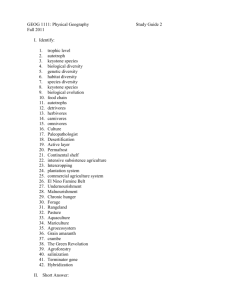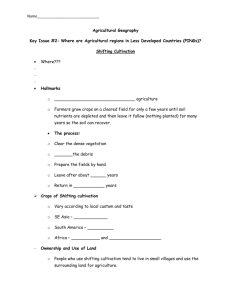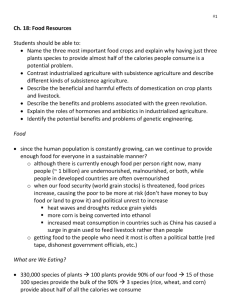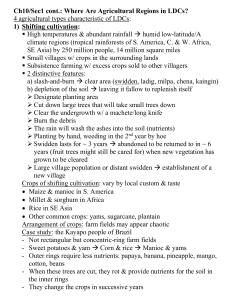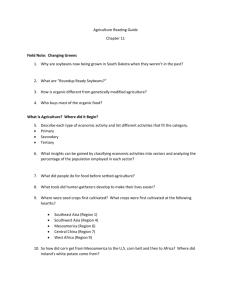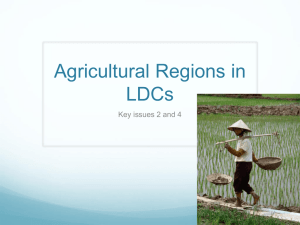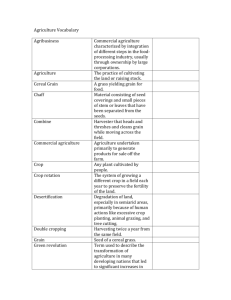How many major agricultural regions are there
advertisement
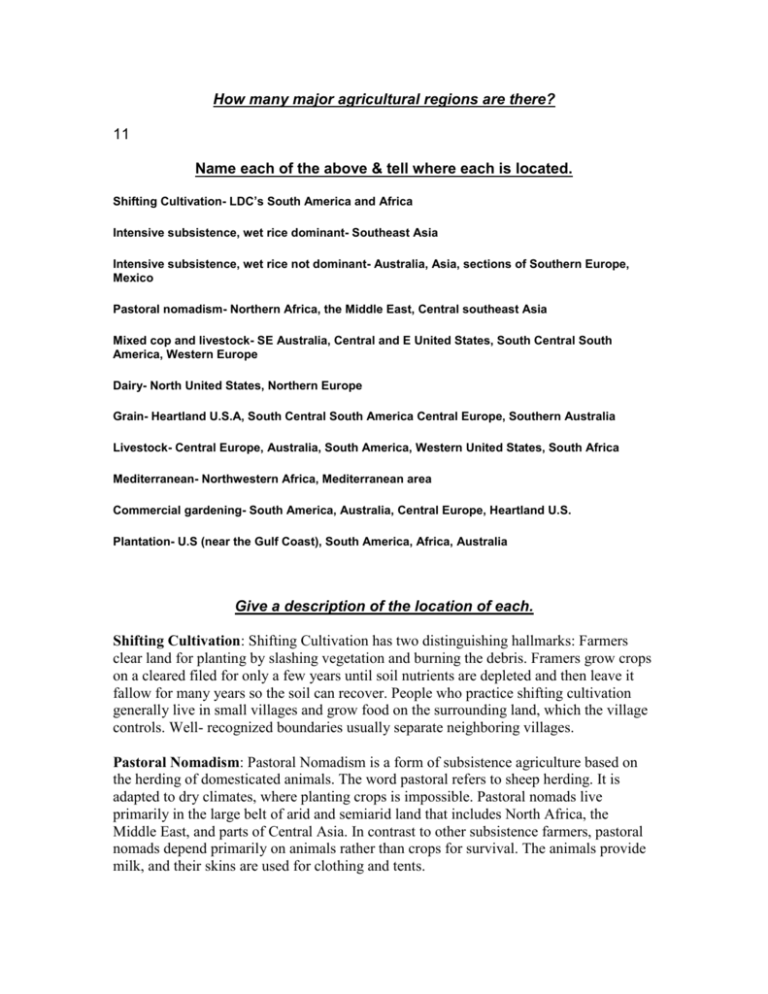
How many major agricultural regions are there? 11 Name each of the above & tell where each is located. Shifting Cultivation- LDC’s South America and Africa Intensive subsistence, wet rice dominant- Southeast Asia Intensive subsistence, wet rice not dominant- Australia, Asia, sections of Southern Europe, Mexico Pastoral nomadism- Northern Africa, the Middle East, Central southeast Asia Mixed cop and livestock- SE Australia, Central and E United States, South Central South America, Western Europe Dairy- North United States, Northern Europe Grain- Heartland U.S.A, South Central South America Central Europe, Southern Australia Livestock- Central Europe, Australia, South America, Western United States, South Africa Mediterranean- Northwestern Africa, Mediterranean area Commercial gardening- South America, Australia, Central Europe, Heartland U.S. Plantation- U.S (near the Gulf Coast), South America, Africa, Australia Give a description of the location of each. Shifting Cultivation: Shifting Cultivation has two distinguishing hallmarks: Farmers clear land for planting by slashing vegetation and burning the debris. Framers grow crops on a cleared filed for only a few years until soil nutrients are depleted and then leave it fallow for many years so the soil can recover. People who practice shifting cultivation generally live in small villages and grow food on the surrounding land, which the village controls. Well- recognized boundaries usually separate neighboring villages. Pastoral Nomadism: Pastoral Nomadism is a form of subsistence agriculture based on the herding of domesticated animals. The word pastoral refers to sheep herding. It is adapted to dry climates, where planting crops is impossible. Pastoral nomads live primarily in the large belt of arid and semiarid land that includes North Africa, the Middle East, and parts of Central Asia. In contrast to other subsistence farmers, pastoral nomads depend primarily on animals rather than crops for survival. The animals provide milk, and their skins are used for clothing and tents. Intensive Subsistence with Wet Rice dominant: The intensive agriculture region of Asia can be divided between areas where wet rice dominates and areas where it does not. The term wet rice refers to the practice of planting rice on dry land in a nursery and then moving the seedlings to a flooded filed to promote growth. Successful production of large yields of rice is an elaborate process, time-consuming and done mostly by hand. Intensive Subsistence with Wet Rice Not Dominant- Climate prevents from growing wet rice in portions of Asia, especially where summer precipitation levels are too low and winters are too harsh. Agriculture in much of interior India and NE China is devoted to crops other than wet rice. Aside from what is grown, this region shares most of the characteristics of intensive subsistence agriculture with the wet-rice region. Land is used intensively and worked primarily by human power with assistance of some hand implements and animals. What is the most important crop, followed by barley. Mixed Crop and Livestock Farming – Mixed crop and livestock is the most common form of commercial agriculture in the United States west of the Appalachians and east of 980 west longitude. The most distinctive characteristic of mixed crop and livestock farming is its integration of crops and livestock. Most of the crops are fed to animals rather than consumed directly to humans. In turn, the livestock supply manure to improve soil fertility to grow more than three-fourths of its income from the sale of animal products. Dairy Faming- Dairy farming is the most important type of commercial agriculture practiced on farms near the large urban areas of the Northeast United States, Southeast Canada, and Northwest Europe. It accounts for approximately 20 percent of the total value of agricultural output throughout Western Europe and North America, Russia, Australia, and New Zealand also have extensive areas devoted to dairy farming. Nearly 60 percent of the world’s supply of milk is produced and consumed in theses developed regions. Livestock Ranching- Ranching is the commercial grazing of livestock over an extensive area. This form of agriculture is adapted to the semiarid or arid land. It is practiced in MDC’s, where the vegetation is too sparse and the soil too poor to support crops. The importance of ranching in the United States extends beyond the number of people who choose this form of commercial farming because of its prominence in popular culture, especially in Hollywood films and television. Mediterranean Agriculture-Mediterranean agriculture exists primarily in the lands that border the Mediterranean Sea in Southern Europe, North Africa, and Western Asia. Farmers in California, central Chile, the southwestern part of South Africa, and SW Australia practice Mediterranean agriculture as well. These areas share a similar physical environment. Every Mediterranean area borders a sea. Mediterranean areas are on west coasts on continents. Prevailing sea winds provide moisture and moderate the winter temperatures. Summers are hot and dry, but sea breezes provide some relief. The land is very hilly and mountains plunge directly to the sea. Commercial Gardening and Fruit Farming-Commercial gardening and fruit farming is the predominant type of agriculture in the U.S. Southeast. The region has a long growing season and humid climate and is accessible to the large markets of New York, Philadelphia, Washington, and the other eastern U.S. urban areas. Truck farms grow many of the fruits and vegetables that consumers demand in more developed societies, such as apples asparagus, cherries, lettuce, mushrooms, and tomatoes. Some of these fruits and vegetables are sold fresh to consumers, but most are sold to large processors for canning or freezing. Plantation Farming- The plantation is a form of commercial agriculture found in the tropics and subtropics, especially in Latin America, Africa, and Asia. Although generally situated in LDC’s. Plantations are often owned or operated by Europeans or North Americans and grow crops for sale primarily in MDC’s. A plantation is a large farm that specializes in one or two crops. Among the most important crops grown on plantations are cotton, sugarcane, coffee, rubber, and tobacco. Also produced in large quantities are cocoa, jute, bananas, tea, coconuts, and palm oil. Latin American plantations are more likely to grow coffee, sugarcane, and bananas, whereas Asian plantation may provide rubber and palm oil.

